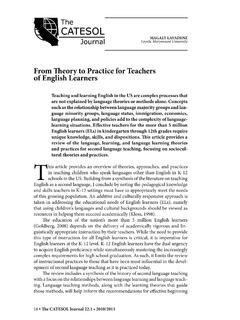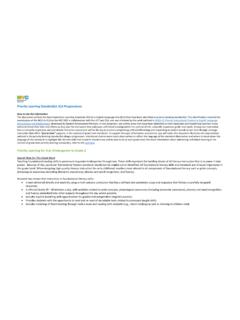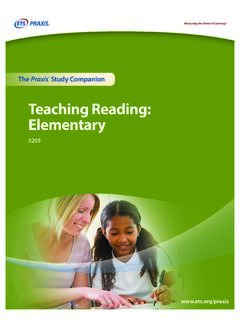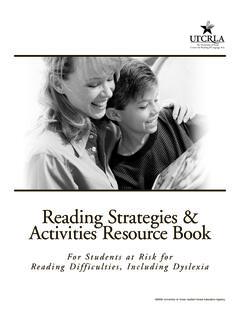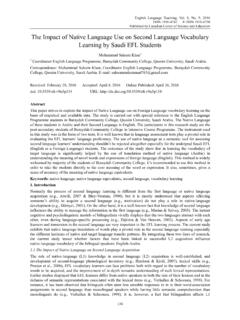Transcription of Essential Strategies for Teaching Phonemic Awareness
1 1 What is Phonemic Awareness and how does it impact reading? Many early childhood and primary grade teachers wrestle with these questions on a daily basis. This section presents the research on Phonemic Awareness and best practices for training students to identify Brief Overview Of Phonemic AwArenessPhonemic Awareness is the ability to focus on and manipulate phonemes in the spoken word (Ehri, Nunes, Willows, & Schuster, 2001). Phonemes are the smallest units in the spoken language, with English containing approximately 41 phonemes (Ehri & Nunes, 2002).
2 Young students often have difficulties letting go of the letters and just concentrating on the sounds in the spoken word. Yet research indicates that Phonemic Awareness and letter knowledge are key predictors to students success in learning to read (National Reading Panel, 2000). In fact, predictive studies show that when children enter kindergarten with the ability to manipulate phonemes and identify letters, they progress at a faster pace in learning to read (Ehri & Roberts, 2006).An ongoing discussion in the field of literacy is whether Phonemic Awareness is a conceptual understanding about language or whether it is a skill.
3 According to Phillips and Torgesen (2006), it is both an understanding and a skill. For example, in order to identify the phonemes in [cat], students must understand that there are sounds at the beginning, middle, and end that can be manipulated. Students must also be able to complete Phonemic Awareness tasks such as the following: Phoneme isolation: Isolate phonemes; for example, Tell me the first sound in cat. Phoneme identity: Recognize common sounds in different words; for example, Tell me the same sound in rug, rat, and roll.
4 Essential Strategies for Teaching Phonemic AwarenessISECTION2 Pr o m o t i n g Li t e r a c y De v eL o P m e n t Phoneme categorization: Identify the word with the odd sound in a sequence; for example, Which word does not belong in sat, sag, rug? Phoneme blending: Combine separate sounds to form a word; for example, [b-a-t] for bat. Phoneme segmentation: Break out the word into separate sounds; for example, What are the sounds in bag? (Ehri et al., 2001)There is also a developmental progression for young children in tackling these Phonemic Awareness tasks.
5 Research indicates that identifying beginning and ending sounds is much easier than recognizing medial phonemes (Inverizzi, 2003). This finding points to the need for explicit, systematic instruction in Phonemic Awareness that is integrated within a literacy program (National Reading Panel, 2000).instructiOn in Phonemic AwArenessMany students enter preschool or kindergarten having already obtained knowledge of letters and sounds through language play or exposure. However, for those who need these concepts and skills, explicit, systematic instruction in Phonemic Awareness will be necessary (Phillips & Torgesen, 2006).
6 It is critical to know that older striving readers and English language learners also benefit from Phonemic Awareness training. Research shows that when English language learners are provided explicit Phonemic Awareness instruction, they are able to catch up with native speakers progress on word identi-fication and spelling (Geva & Siegel, 2000).The key to success is data-driven instruction that uses assessment to determine students level of phonological Awareness . phonological Awareness is the broader construct for knowing speech sounds, rhyming, and alliteration and includes Phonemic Awareness (Inverizzi, 2003).
7 When teachers use data to inform instruction, targeted sessions are implemented on specific needs such as phoneme blending or categorization. It is also important to note that data may determine that some students do not require instruction in Phonemic Awareness as they already possess the concept and skill. According to the National Reading Panel (2000), effective Phonemic Awareness instruction occurs in small groups and is combined with letter identification to aid transfer of skills to reading.
8 This chapter presents several Strategies that use guidelines formed from research on best practice to instruct students in identifying and manipulating fOr Teaching Phonemic AwArenessDuring the past several years, a body of research indicates that early, systematic, explicit Phonemic Awareness instruction can successfully jump-start emergent and early readers reading performance (McGee & Ukrainetz, 2009). The following guidelines provide the framework for Phonemic Awareness instruction: 1. Analysis of Phonemic Awareness assessment data should drive instruction, as only a small percentage of students need explicit instruction (Ehri & Roberts, 2006).
9 2. Phonemic Awareness instruction should be a positive, enriching experience that allows students to engage in language play (Yopp, 1992).Section i Essential Strategies for Teaching Phonemic Awareness 3 3. Effective Phonemic Awareness instruction provides for individual differences in abilities and uses leveled scaffolding to facilitate growth (McGee & Ukrainetz, 2009). 4. Developmentally appropriate Phonemic Awareness instruction uses chants, poetry, songs, and rhymes to engage students curiosity about language and to develop metalinguistic Awareness (Yopp & Yopp, 2000).
10 5. Effective Phonemic Awareness instruction explicitly labels sounds and demon-strates the process of blending-segmenting of sounds (Ehri et al., 2001).A strAteGy fOr AssessinG Phonemic AwArenessResearch indicates that Phonemic Awareness tasks are the best predictors of students success with reading acquisition (Yopp, 1995). Due to its critical nature, it is imperative that teachers assess students Phonemic Awareness skills in order to differentiate instruction or to provide intervention if necessary (Ehri et al.)











